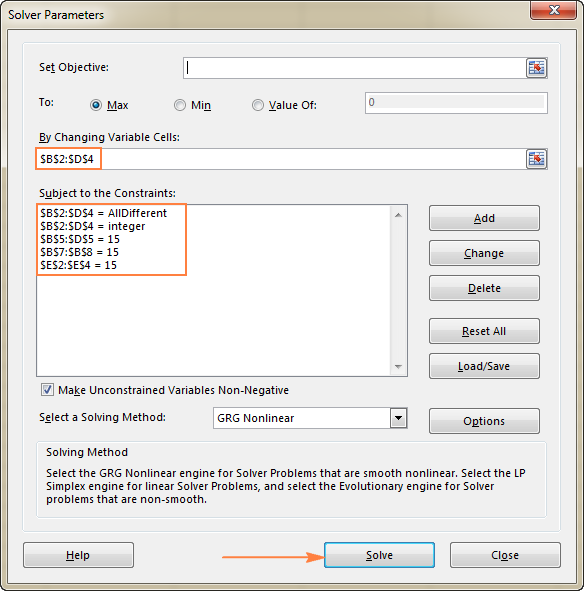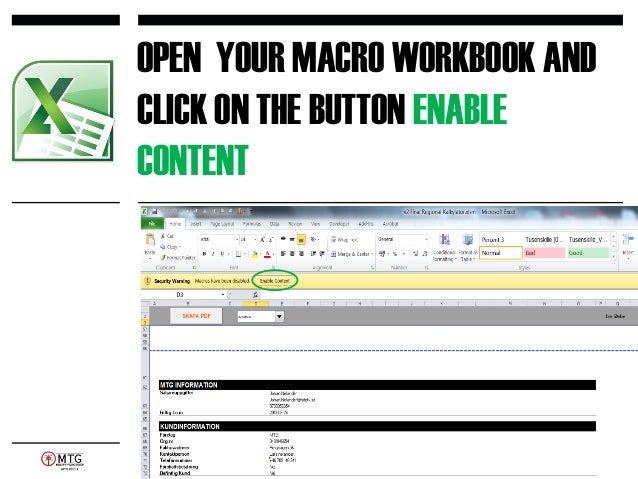How To Enable Solvertable In Excel For Mac
- An Example File
- How To Install Solver Table 2007 In Microsoft Excel 2010 ...
- Using Frontline Solvers On Macintosh | Solver
- How To Use Excel Solver
O For Solver that ships with Excel for Mac: SolverTable for Mac.zip ¨ (Note: If you downloaded this zip before, download this version instead. The previous version didn’t recognize when a model has no feasible solutions. This version corrects the problem.) This version of SolverTable was created for the Mac in October 2020. Open Excel for Mac 2019. Go to the Tools menu, select 'Add-ins'. Check 'Solver Add-in' and 'Analysis ToolPak' then click OK. Select the 'Data' tab, then select 'Solver' or 'Data Analysis'. O For Solver that ships with Excel 2019 or Office 365: There is no “new” SolverTable add-in for either of these. As far as I’m aware, SolverTable for Excel 2016 should work fine with either of these. I’m currently using it with Office 365 and haven’t run into any problems. O For Solver that ships with Excel 2016: SolverTable 2016.zip.
Free Downloads
- Copy formulas into adjacent cells by using the fill handle. When you drag the handle to other cells, Excel shows different results for each cell. You can change how you want to fill cells after you finish dragging.
- Microsoft 365 includes premium Word, Excel, and PowerPoint apps, 1 TB cloud storage in OneDrive, advanced security, and more, all in one convenient subscription. With Microsoft 365, you get features as soon as they are released ensuring you’re always working with the latest. Create, view, edit, and share your spreadsheets using Excel for Mac.

Watch this page for free downloads as they become available.
·DADM_Tools add-in: For various reasons, some users of our DADM and PMS books prefer not to use the Palisade add-ins discussed in these books. To provide another alternative, I created my own add-in called DADM_Tools that provides much of the basic functionality of the Palisade software. This add-in, written in Excel’s VBA language, is not used in the books but it is available here for free. Because it is totally free, no support is available. However, it is very easy to use, and it is compatible with Excel for Windows and Excel for Mac. Here is a link to instructions: DADM_Tools Help.docx. Here is a link to the add-in: DADM_Tools.xlam.
·Random Functions Add-Ins: The DADM_Tools add-in mentioned in the previous bullet includes, among other things, a simulation program. For technical reasons, the custom functions I developed to generate random numbers from various probability distributions are not included in the DADM_Tools add-in. However,…
oFor Windows users, the random functions are contained in a special type of add-in (an XLL that works only with Excel for Windows 2010 or higher). First read the following: RandGen Add-In.docx (updated 1/24/2019). Then install the add-in by running the Setup file in: RandGenSetup.zip.
oFor Mac users, the random functions are in the following add-in: Random Functions for the Mac.xlam.
·Excel tutorial: Here is a free version of my Excel tutorial: Excel Tutorial for Windows.xlsx. It provides information for upgrading to a more complete version called ExcelNow!. You can also download a version of the tutorial for the Mac: Excel Tutorial for the Mac.xlsx. By comparing these, you can see which features in Excel for Windows are not included in Excel for Mac.
·Analysis ToolPak Guide: This is a supplement to our books for those of you who would like to use Excel’s built-in Analysis ToolPak add-in for statistical analysis. The zip file contains a pdf version of the guide and accompanying data files: Analysis ToolPak Guide.zip
·SolverTable Add-in: Each version below has a corresponding Help file (a Word file) that you should read before contacting me about problems. Each zip file below contains only two files: the .xla or .xlam add-in file and the Word help file. You should unzip both to the same folder (any folder of your choice) and then read the help file for more instructions.
An Example File
oSolverTable tip for international users: A user from outside the US discovered why his SolverTable wasn’t working. The problem was in the numerical settings (decimal symbols and list separators), and the fix was to change these in Windows settings, making sure the separator is a period, not a comma. I’m not sure how common this problem might be, but if you’re outside the US and your SolverTable isn’t working, this is worth a try.
oFor Solver that ships with Excel for Mac: SolverTable for Mac.zip
¨(Note: If you downloaded this zip before 10/30/2020, download this version instead. The previous version didn’t recognize when a model has no feasible solutions. This version corrects the problem.) This version of SolverTable was created for the Mac in October 2020. The essence of SolverTable has always been that it makes multiple uninterrupted Solver runs. For technical reasons, this is not possible in Excel for Mac, which explains why a version of SolverTable had never been available for the Mac. However, this new version gets around the problem by making interrupted Solver runs. Specifically, before each run, you are prompted whether you want to make the next run. (This is explained more fully in the help file that is part of this zip file.) Admittedly, the interruptions slow down the process to some extent (besides the fact that Solver for the Mac is just plain slow), but it is much better than making multiple Solver runs manually, each with new input values. Fortunately, the user interface and the results sheets are exactly the same as those for the Windows version of SolverTable.
oFor Solver that ships with Excel 2019 or Office 365: There is no “new” SolverTable add-in for either of these. As far as I’m aware, SolverTable for Excel 2016 should work fine with either of them. I’m currently using it with Office 365 and haven’t run into any problems.
oFor Solver that ships with Excel 2016: SolverTable 2016.zip
¨This version is basically the same as the 2013 version.
oFor Solver that ships with Excel 2013: SolverTable 2013.zip
¨This version wasn’t created because SolverTable 2010 wouldn’t work with Excel 2013. Rather, I made some technical changes in the software. Probably the main change is that this version now starts each Solver run from the original solution in the decision variable cells. (In previous versions, it started each Solver run from the previous Solver solution.)
¨Modified on 10/5/2015 to open the Help file in a simpler manner (less possibility of an error occurring).
oFor Solver that ships with Excel 2010:SolverTable 2010.zip
¨Modified on 10/5/2015 to open the Help file in a simpler manner (less possibility of an error occurring).
¨Modified on 4/26/2012 to fix a problem with long worksheet names. Basically, Excel allows worksheet names to be no longer than 31 characters. SolverTable creates a hidden sheet with its settings, and the name of the sheet is the model sheet name plus the suffix “_STS”. So if the name of your model sheet has from 28 to 31 characters, this would create an error. SolverTable now warns you before the error occurs.
¨Modified on 12/5/2011 to fix a potential sheet-naming problem.
¨Modified on 11/8/2011 to fix a potential problem where a user mistakenly selects the Simplex LP method on a nonlinear model. The previous code could get into an infinite loop in this case. A similar fix was made (see below) to the 2007 and 2003 versions. However, this 2010 version might not work correctly in 2007 or 2003 because of a subtle code change Frontline Systems made in its 2010 version of Solver.
¨Modified on 10/7/2010 to fix a bug that occurred when a user mistakenly ran SolverTable from an STS sheet (not a model sheet)
¨Modified on 9/24/2010 to make it compatible with the GRG Nonlinear Multistart option
¨Modified on 9/3/2010 to be compatible with 64-bit Office 2010.
oFor Solver that ships with Excel 2007:SolverTable 2007.zip
¨Modified on 4/26/2012 – see point 2 above for the 2010 version
¨Modified on 12/5/2011 – see point 3 above for the 2010 version
¨Modified on 11/8/2011 – see point 4 above for the 2010 version
¨Modified on 10/7/2010 to fix a bug that occurred when a user mistakenly ran SolverTable from an STS sheet (not a model sheet)
oSolverTable fix: For those of you who have problems with SolverTable, here are instructions for a possible fix: Fixing SolverTable.docx.
How To Install Solver Table 2007 In Microsoft Excel 2010 ...
oMissing Solver Reference: Here is another possible fix for SolverTable: Missing Solver Reference.docx
oA strange SolverTable problem: Reynold Byers and his students at Arizona State discovered that in a straightforward integer-constrained model, SolverTable gave slightly suboptimal solutions. I originally thought this had to do with the Integer Optimality setting, but that wasn’t it. They found that the decimal input being varied, something like from 0 to 0.6 in increments of 0.1, was not being set to exactly 0.4, say, but instead to something like 0.400025 – a slight roundoff – and this was enough to cause the suboptimal solutions. Great detective work on their part, but I’m not sure how to fix the problem. Anyway, be aware!
oAn interesting use of SolverTable: One way to use SolverTable is to let the Input cell(s) (for a one-way or two-way table) be the initial value(s) of decision variable cell(s). For a linear model, the only point in doing this would be to check that Solver indeed gets to the optimal solution regardless of the initial values. For a nonlinear model, this could be used to check whether there are local optima that Solver might get to, depending on the initial values it starts from. For example, for problem 7.48 of PMS 3e, which has exactly two decision variable cells, it is easy to show that Solver gets to the global optimum only for some initial values of the decision variable cells. (Thanks to Tom Schriber for this suggestion.)
·StatPro and StatBasics Add-Ins
oStatPro for Excel 2007 and later: Although I no longer support StatPro, I tinker with it from time to time, and this version is the result: StatPro New.zip. It doesn’t have all the options from the original StatPro (e.g., stepwise regression is missing), but it has some new features and a slightly different interface. It is contained in a single .xla file, and it works with Excel 2007 and later versions. To load it, just double-click the .xla file.
oStatPro for the Mac: Some of you have requested a version of StatPro for the Mac, that is, for the Mac version of Excel. This was originally impossible because early version of Excel for Mac didn’t even have VBA, the programming language. That changed in Excel 2011, but the VBA interface is quite different from the one in Excel for Windows. Anyway, I gave it a shot, and you can try out this version: StatPro for Mac.zip. However, you’re completely on your own; I provide no support for this version. VBA programming for the Mac is no fun!
oStatBasics for Excel 2007: StatBasics for Excel 2007.zip. This is a mini version of StatPro I created, mostly to practice my programming skills. It provides only the basics: summary measures and useful statistical charts. Installation instructions are in the zip file. Try it out, but keep in mind that I do not provide any support for it.

- NCAA March Madness simulation: Here is the simulation for 2019: March Madness 2019 with Data Table.xlsx. Also, here is a version that calculates the probability of a perfect bracket, i.e., successfully predicting the winner of each game: March Madness Probabilities 2013.xlsx. (I didn’t update this file after 2013, but you can if you like. The probability of picking all winners will still be infinitesimally small.)
- Transient queueing analysis: Transient Queue.xlsm Did you know that you can analyze queues with time-varying behavior (e.g., arrival rates that increase during peak periods of the day) with spreadsheets, using analytical approximations, not simulation or steady-state analysis? This is indeed possible, as Wayne Winston described in the 4th edition of his Operations Research book. Although Wayne's approach is to use Excel formulas, this file uses a VBA program to perform the calculations. Enjoy!
- Automating Sudoku with VBA: Sudoku.xlsm (or Sudoku16.xlsm) If you love the laborious effort of working Sudoku puzzles—the pencil marks, the erasing, etc.—then you should not open these files. But if you want to see how powerful VBA programs can be, check out the Sudoku.xlsm file. (You can even view the VBA code to see how it works.) And if you want to go a step farther, with 16x16 grids instead of the usual 9x9 grids, check out the Sudoku16.xlsm file. (Note: I changed these files slightly in April 2016. Specifically, the Sudoku.xlsm file now has an Algorithm sheet that walks you through the algorithm implemented in the VBA code. The VBA code is a bit hard to follow – a lot of nested loops – but the algorithm, i.e., the plan of attack, itself is quite straightforward.)

Visit the Cengagesite for our books.
Send e-mail to albright@indiana.edu
Albright and Winston are both retired from the Kelley School of Business, Indiana University, Bloomington.
Back to home page

Updated: 12/2/2020
In Excel for Windows, if you don't see the Solver command or the Analysis group on the Data tab, you need to load the Solver add-in.
1. Click the File tab, click Options, and then click the Add-ins category.
2. In the Manage box, click Excel Add-ins, and then click Go.
3. In the Add-ins available box, select the Solver Add-in check box. If you don't see this name in the list, click the Browse... button and navigate to the folder containing Solver.xlam. Then click OK.
4. Now on the Data tab, in the Analysis group, you should see the Solver command.
In Excel for Macintosh, if you don't see the Solver command on the Tools menu, you need to load the Solver add-in.
1. Click the Tools menu, then click the Add-ins command.
2. In the Add-ins available box, select the Solver.xlam check box. If you don't see this name in the list, click the Select... button and navigate to the folder containing Solver.xlam. Then click OK.
3. Now on the Tools menu, you should see the Solver command.
In Excel Online for Office 365, Excel Web App for SharePoint, or Excel on iPad, use the Solver add-in. If you don't see the Solver Task Pane in your worksheet, you need to insert the Solver add-in: Follow the steps in Microsoft Office Support on How to get an Office Add-in for Excel.
1. Open the workbook where you want to use Solver. Click the Insert tab, then click the My Add-ins button.
2. If Solver appears in the Recently Used Add-ins dropdown list, select it there, and skip to step 4.
3. Select See All... from the dropdown menu. In the Office Add-ins dialog, find and select Solver under
My Add-ins or My Organization.
If this is your first time using the Solver add-in, click Store, and look in the Data Analytics category. Click to see the Solver add-in listing in the Office Store.
4. The Solver Task Pane should appear. Click File Save As, and save to your Office 365 or SharePoint document library, or OneDrive or OneDrive for Business folder.
Using Frontline Solvers On Macintosh | Solver
5. Now when you open your workbook, the Solver Task Pane should appear automatically.
How To Use Excel Solver
NOTE: Although the Solver add-in can be used in Excel 2013 and Excel 2016, because your model is solved 'in the cloud,' this Solver add-in works only with Excel workbooks that are stored online. If you want to solve a workbook model that is stored on your local PC, use the Solver included with desktop Excel, or one of Frontline's enhanced Solvers for desktop Excel.